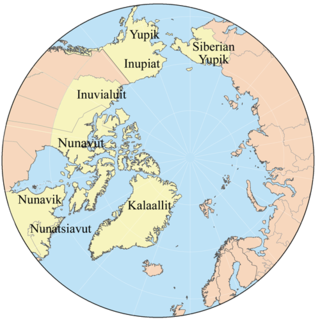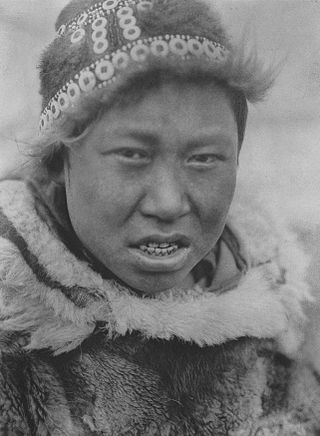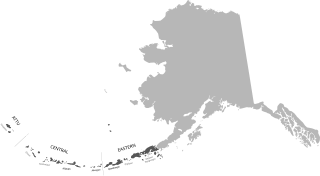
Eskimo is an exonym that refers to two closely related Indigenous peoples: Inuit and the Yupik of eastern Siberia and Alaska. A related third group, the Aleut, who inhabit the Aleutian Islands, are generally excluded from the definition of Eskimo. The three groups share a relatively recent common ancestor, and speak related languages belonging to the family of Eskaleut languages.

The Inuit languages are a closely related group of indigenous American languages traditionally spoken across the North American Arctic and the adjacent subarctic regions as far south as Labrador. The Inuit languages are one of the two branches of the Eskimoan language family, the other being the Yupik languages, which are spoken in Alaska and the Russian Far East. Most Inuit people live in one of three countries: Greenland, a self-governing territory within the Kingdom of Denmark; Canada, specifically in Nunavut, the Inuvialuit Settlement Region of the Northwest Territories, the Nunavik region of Quebec, and the Nunatsiavut and NunatuKavut regions of Labrador; and the United States, specifically in northern and western Alaska.

The Yupik are a group of Indigenous or Aboriginal peoples of western, southwestern, and southcentral Alaska and the Russian Far East. They are related to the Inuit and Iñupiat. Yupik peoples include the following:

The Eskaleut, Eskimo–Aleut or Inuit–Yupik–Unangan languages are a language family native to the northern portions of the North American continent, and a small part of northeastern Asia. Languages in the family are indigenous to parts of what are now the United States (Alaska); Canada including Nunavut, Northwest Territories, northern Quebec (Nunavik), and northern Labrador (Nunatsiavut); Greenland; and the Russian Far East. The language family is also known as Eskaleutian, Eskaleutic or Inuit–Yupik–Unangan.

Aleut or Unangam Tunuu is the language spoken by the Aleut living in the Aleutian Islands, Pribilof Islands, Commander Islands, and the Alaska Peninsula. Aleut is the sole language in the Aleut branch of the Eskimo–Aleut language family. The Aleut language consists of three dialects, including Unalaska, Atka/Atkan, and Attu/Attuan.

Siberian Yupiks, or Yuits, are a Yupik people who reside along the coast of the Chukchi Peninsula in the far northeast of the Russian Federation and on St. Lawrence Island in Alaska. They speak Central Siberian Yupik, a Yupik language of the Eskimo–Aleut family of languages.

Sirenik Yupik, Sireniki Yupik, Sirenik, or Sirenikskiy is an extinct Eskimo–Aleut language. It was spoken in and around the village of Sireniki (Сиреники) in Chukotka Peninsula, Chukotka Autonomous Okrug, Russia. The language shift has been a long process, ending in total language death. In January 1997, the last native speaker of the language, a woman named Vyjye, died. Ever since that point, the language has been extinct; nowadays, all Sirenik Eskimos speak Siberian Yupik or Russian.

Greenlandic is an Eskimo–Aleut language with about 57,000 speakers, mostly Greenlandic Inuit in Greenland. It is closely related to the Inuit languages in Canada such as Inuktitut. It is the most widely spoken Eskimo–Aleut language. In June 2009, the government of Greenland, the Naalakkersuisut, made Greenlandic the sole official language of the autonomous territory, to strengthen it in the face of competition from the colonial language, Danish. The main variety is Kalaallisut, or West Greenlandic. The second variety is Tunumiit oraasiat, or East Greenlandic. The language of the Inughuit of Greenland, Inuktun or Polar Eskimo, is a recent arrival and a dialect of Inuktitut.

The Yupik languages are a family of languages spoken by the Yupik peoples of western and south-central Alaska and Chukotka. The Yupik languages differ enough from one another that they are not mutually intelligible, although speakers of one of the languages may understand the general idea of a conversation of speakers of another of the languages. One of them, Sirenik, has been extinct since 1997.

Iñupiaq or Inupiaq, also known as Iñupiat, Inupiat, Iñupiatun or Alaskan Inuit, is an Inuit language, or perhaps group of languages, spoken by the Iñupiat people in northern and northwestern Alaska, as well as a small adjacent part of the Northwest Territories of Canada. The Iñupiat language is a member of the Inuit-Yupik-Unangan language family, and is closely related and, to varying degrees, mutually intelligible with other Inuit languages of Canada and Greenland. There are roughly 2,000 speakers. Iñupiaq is considered to be a threatened language, with most speakers at or above the age of 40. Iñupiaq is an official language of the State of Alaska, along with several other indigenous languages.

Haida is the language of the Haida people, spoken in the Haida Gwaii archipelago off the coast of Canada and on Prince of Wales Island in Alaska. An endangered language, Haida currently has 24 native speakers, though revitalization efforts are underway. At the time of the European arrival at Haida Gwaii in 1774, it is estimated that Haida speakers numbered about 15,000. Epidemics soon led to a drastic reduction in the Haida population, which became limited to three villages: Masset, Skidegate, and Hydaburg. Positive attitudes towards assimilation combined with the ban on speaking Haida in residential schools led to a sharp decline in the use of the Haida language among the Haida people, and today almost all ethnic Haida use English to communicate.
Vafsi is a dialect of the Tati language spoken in the Vafs village and surrounding area in the Markazi province of Iran. The dialects of the Tafresh region share many features with the Central Plateau dialects.

Naukan Yupik language or Naukan Siberian Yupik language is a critically endangered Eskimo language spoken by c. 70 Naukan persons (нывуӄаӷмит) on the Chukotka peninsula. It is one of the four Yupik languages, along with Central Siberian Yupik, Central Alaskan Yup'ik and Pacific Gulf Yupik.
The Alutiiq language is a close relative to the Central Alaskan Yup'ik language spoken in the western and southwestern Alaska, but is considered a distinct language. It has two major dialects:
Central Alaskan Yupʼik is one of the languages of the Yupik family, in turn a member of the Eskimo–Aleut language group, spoken in western and southwestern Alaska. Both in ethnic population and in number of speakers, the Central Alaskan Yupik people form the largest group among Alaska Natives. As of 2010 Yupʼik was, after Navajo, the second most spoken aboriginal language in the United States. Yupʼik should not be confused with the related language Central Siberian Yupik spoken in Chukotka and St. Lawrence Island, nor Naukan Yupik likewise spoken in Chukotka.
Sirenik or Sireniki are former speakers of a divergent Eskimo language in Siberia, before its extinction. The total language death of this language means that now the cultural identity of Sirenik Eskimos is maintained through other aspects: slight dialectal difference in the adopted Siberian Yupik language; sense of place, including appreciation of the antiquity of their settlement Sirenik.

The Nias language is an Austronesian language spoken on Nias Island and the Batu Islands off the west coast of Sumatra in Indonesia. It is known as Li Niha by its native speakers. It belongs to the Northwest Sumatra–Barrier Islands subgroup which also includes Mentawai and the Batak languages. It had about 770,000 speakers in 2000. There are three main dialects: northern, central and southern. It is an open-syllable language, which means there are no syllable-final consonants.
The consequential mood is a verb form used in some Eskaleut languages to mark dependent adverbial clauses for reason ('because') or time ('when'). Due to the broader meaning of the term mood in the context of Eskimo grammar, the consequential can be considered outside of the proper scope of grammatical mood.

Naukan is a deserted Yupik village on Cape Dezhnev, Russia. Prior to 1958, it was the easternmost settlement in the Eurasian continent. This distinction is now held by the Russian village Uelen in the Chukotsky District.
The Chaplino dialect is a dialect of the Central Siberian Yupik language spoken by the indigenous Eskimo people along the coast of Chukotka Autonomous Okrug in the Russian Far East, in the villages of Novoye Chaplino, Provideniya, Uelkal and Sireniki. The Chaplino dialect is named after the village of Chaplino. The Chaplino dialect is spoken by the majority of Russian Yuits.














